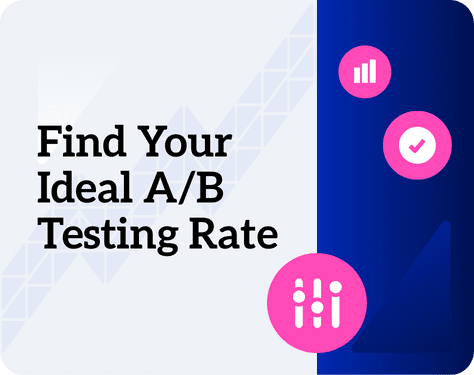Static testing and dynamic testing are terms typically associated with the software development and QA process. When comparing the two approaches, it’s a case of manual versus automated approaches. Static testing is done manually without executing the application (e.g., reading the code to assess for syntax errors) and dynamic testing is an automated approach that involves executing the code and testing it in various ways within a closed run-time environment.
There’s a hybrid approach to testing that can be both manual and automated – for example, you may have checklist where you manually review code but use syntax checkers to speed up the process.
Static and dynamic testing approaches aren’t limited to application development. They can be applied to digital marketing and customer experience (CX) scenarios to review the performance of a given element or combination of elements – a landing page, a customized website experience, ad messaging, or some other digital experience. This is the kind of testing that Monetate’s dynamic testing software supports.
What is Static Testing?
Static testing is the process of checking an application or website without executing the code. It’s a manual process. A code reviewer compares the codebase against requirements documents and design specifications to identify potential defects, flaws, or areas of non-compliance. Static testing is typically done early in the development lifecycle.
As a verification technique, static testing aims to enhance the overall quality and maintainability of the thing being tested – for applications, that means the software itself. For customer experiences – that means the viability of a given approach.
Static Testing Techniques & Examples for CX
From perspective of testing CX before launch, some potential static testing techniques could include:
- Customer Journey Mapping: Reviewing user flows, wireframes, and prototypes to identify potential usability issues or experience gaps.
- Heuristic Evaluations: Having usability experts inspect designs against established heuristics to catch violations early.
- Content/Data Audits: Verifying website content, metadata, product data is accurate and up-to-date.
- Accessibility Audits: Manually inspecting user interfaces against accessibility guidelines like WCAG.
- Persona Definition Reviews: Validating audience segment definitions and personalization rules align with target user personas.
Challenges and Benefits of Static Testing
Disadvantages
- May not catch all usability issues and flaws that manifest in real user sessions and actual customer interactions.
- Heavily reliant on the expertise of reviewers evaluating designs/prototypes.
- Time-consuming for very complex customer journeys and experiences.
- Solely relying on static CX testing doesn’t provide a complete picture of the entire CX.
Advantages
- Identifies potential experience issues upfront before broader rollout.
- Helps prevent poor user journeys and fragmented experiences earlier than if testing wasn’t implemented.
- Facilitates collaboration across teams and departments when defining optimal CX flows.
- Covers review of all elements that impact CX – wireframes, designs, user research, etc.
- Helps to positively impact performance metrics (ROI, sales, etc.) by de-risking experiences before launching to customers.
What is Dynamic Testing for CX?
Dynamic testing for customer experiences is the process of executing controlled tests and experiments on live digital platforms with real user traffic. Rather than just manually reviewing designs or prototypes, dynamic CX testing deploys different experience variations to understand how users behave so you can analyze engagement metrics, conversion rates, and other performance data.
Dynamic CX testing allows you to accurately assess of how customers perceive and interact with the live experiences. The results, which are often available in real time, then let you optimize different experiences and present the highest performing versions dynamically.
Dynamic Testing Techniques & Examples for CX
- A/B Testing: Tests two versions of an element to see which one performs better. homepage
- Multivariate Testing: Evaluates multiple layouts, product placements, experiences to see how different combinations of elements impact metrics.
- Funnel/User Journey Analysis: Tests different paths and sequences of steps within a funnel or user journey flow.
- Load/Traffic Testing: Evaluates performance under high traffic volumes or load conditions.
- Real User Monitoring: Tracks and analyzes user behaviors across different sections of the site/app.
- Personalization Algorithms: Uses machine learning algorithms to dynamically adapt and tailor experiences.
Challenges and Benefits of Dynamic Testing
Disadvantages
- Can be time-consuming for complex experiments with many variations.
- Likely won’t cover every potential user scenario and edge case.
- Requires upfront investment in testing tools/platforms.
Advantages
- Validates actual user behavior rather than just reviewing artifacts (e.g., user journey maps, static documentation, designs, wireframes, etc.)
- Allows for continuous optimization of multiple experience variations.
- Controlled experiments let you roll out new features and experiences with minimal risk.
- Automated testing means you can quickly scale testing and try limitless CX scenarios.
- Real-time monitoring allows for timely CX optimization and adjustments.
How to Choose Between a Static Testing vs. Dynamic Testing Strategy?
The approach you use for testing CX should be tied to your objectives and where you’re at in the journey optimization process. Static testing techniques like journey mapping, heuristic evaluations, and data audits are great tools when you’re just starting out. They help identify potential usability issues. They can also help you optimize designs before launch.
Dynamic testing, on the other hand, lets you test many experiences and scale quickly. It’s a comprehensive approach to rolling out new experiences that provides more complete validation. By experimenting with live users, you’re able to analyze actual behaviors, engagement metrics, and business impact.
A combined static and dynamic approach can is often most effective, regardless of where you’re at in the CX optimization process. Use static methods initially, then dynamically test variations through controlled experiments once deployed. Once you’re working with existing experiences, dynamic testing allows continuous improvement by executing A/B and multivariate tests iteratively.



